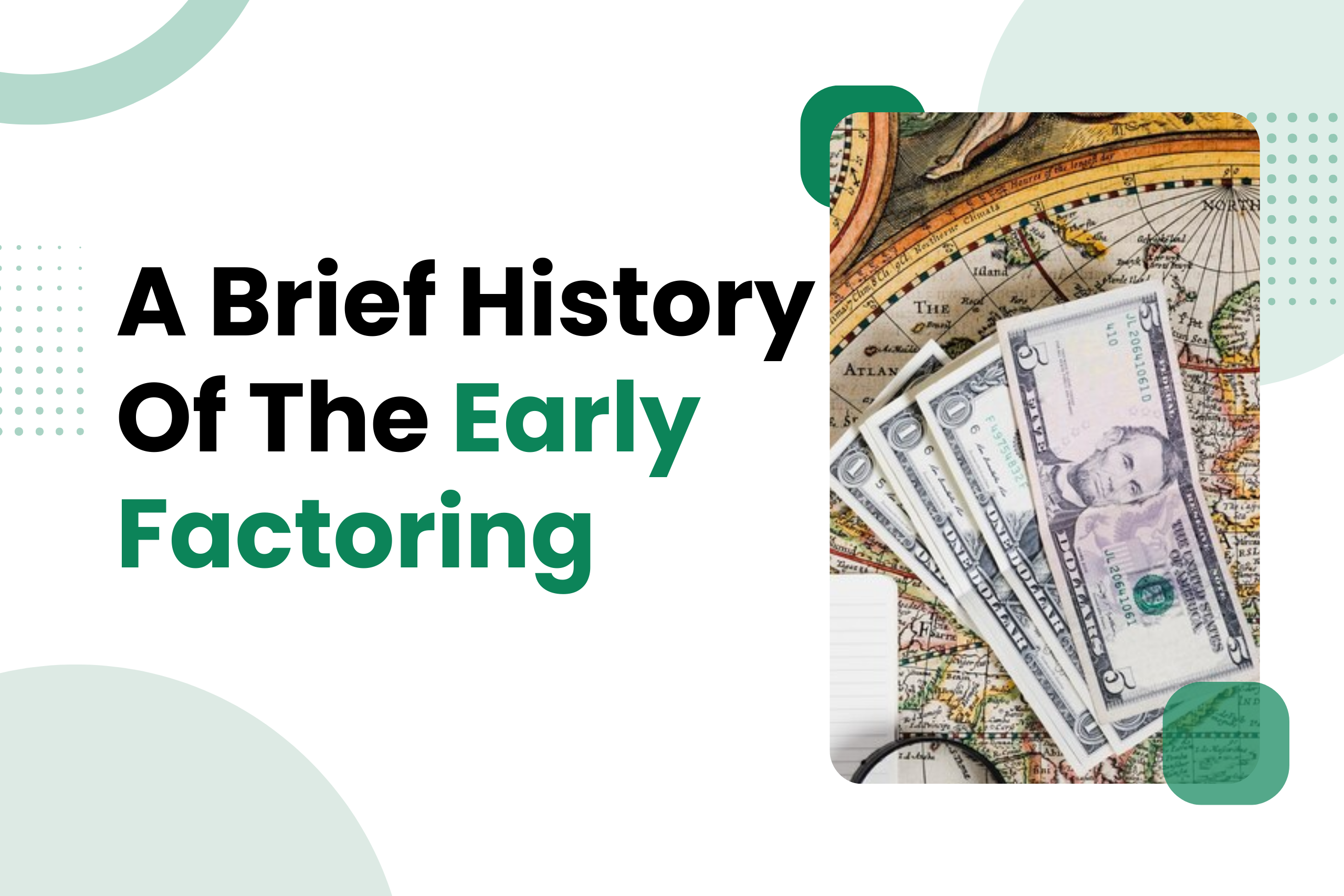It is common today for many to view Factoring as a new and creative way to finance businesses that do not otherwise qualify for what is viewed as “traditional” financing.
What Is Factoring In Finance is a question that often arises from this misconception. This is not a historically accurate view. Those of us engaged in the Factoring industry or who provide goods and services to the Factoring industry need to remind ourselves of this periodically. We are engaged in a form of financing that is centuries older than, for example, modern banking. Modern banking, which is one of those “traditional” forms of financing, has its antecedents in Italy during the renaissance.
Factoring is much older. It is, in fact, one of the oldest, if not the oldest form of financing known to man. There is significant evidence to indicate that Factoring was known in Biblical times. Fragments of writings from both the ancient Egyptians and the Phoenicians strongly suggest that the businessmen from both of these ancient peoples engaged in what we would today call Factoring. There is even more evidence, in terms of volume, that Factoring was common in ancient Mesopotamia. Many of the clay tablets from the region containing cuneiform writings indicate that the businessmen of that area also engaged in factoring. The reason the volume of evidence is greater in the Mesopotamia area is that baked clay lasts longer than papyrus. Papyrus, a paper like substance is what the Egyptians and Phoenicians used in their record keeping. There is no reason to believe that Factoring was used any more in Mesopotamia than in the other two areas. It’s just that the records of Mesopotamia have greater durability. (Is there some lesson to be drawn from this?)
Understanding What Is Factoring In Finance requires appreciating its deep roots. It has not been documented as having been used by the Romans. However, the word “Factoring” has a Roman root. It is derived from the Latin verb “facio” which can be translated as “he who does things.” In Roman times this referred to the agent of a property owner, i.e., his business manager. Though the root word has nothing to do with the industry today (actually the French word for “invoice” is “facture” and in Spanish it is “factura”), I like to think that it reflects the attitude and approach of the people in our industry, as they attempt to help their clients through their financial problems.
In Britain , Factoring began to be commonly used as a result of the growth and development of the wool industry. This occurred in the fourteenth century. The business ancestor of the commercial Factor, at that time acted as selling agent for the owner of a woolen mill. Initially this might be thought of as the middle ages’ version of a manufacture’s representative. The slowness of communications during those times made business transactions cumbersome, even over what we would now consider relatively short distances. The “Factor” of that day made all of the decisions for his area with regard to such matters as what may be the popular in his local market. He would then have the goods shipped to himself and he assumed the risk of getting paid for all of the goods he sold on credit in his area, i.e., he made the credit decision. It was in this way, that the commercial Factor, as we know it today, began to slowly develop and emerge.
In this system the Factor was assuming what we today call the credit risk. He also billed in his own name. His service to what was then viewed as the distant mill owner was to be able to remit a large percentage of the unpaid accounts. He did reserve, i.e., hold back, 20-25%, on such accounts, to cover disputes and claims of defective goods, both of which remained the risk of the mill owner. He also covered whatever his fee was from the reserve. All of this of course sounds very familiar to us today.
Factoring arose in the United States during the 19th century, as a direct result of the inability of manufacturers to maintain constant and timely communications with their sales forces in the field. At that time, as is the case today, the sales force was paid by commission. If all sales were at the risk of the manufacturer, the salesmen had no incentive to exercise prudence in connection with whom he sold to on credit. On the other hand, the distant manufacturer was not in a position to make the credit judgment from afar. This gave rise to the practice of having salesmen assume the credit risk on sales. The risk of defective or non-conforming merchandise remained with the manufacturer. The credit risk was now separated from disputes as to quality, workmanship and conformity of the goods. Soon after the salesmen began to act as independent sales agencies. It was common for them to act for more than one manufacturer. Still later, the sales function was separated from the credit function and What Is Factoring In Finance, in its traditional form, had at that point developed in the United States.
There have been many developments and permutations in the industry since traditional Factoring emerged during the last century in the form we know and recognize today. All of these changes and permutations are beyond the scope of this article. The purpose of this article is solely to remind all of us of the long and useful history of our industry, which I am confident will continue into the new millennium.
This passage provides a comprehensive overview of the history of factoring, emphasizing its longevity and significance in the evolution of finance. Here are the key points summarized:
Ancient Origins: Factoring is one of the oldest forms of financing, with evidence suggesting its use during Biblical times, as well as by ancient Egyptians, Phoenicians, and in Mesopotamia, where durable clay tablets offer more substantial evidence.
Roman Influence: The term “factoring” is derived from the Latin word “facio,” meaning “he who does things,” referring to an agent or business manager. Although factoring was not documented in Roman practices, the etymology reflects the service-oriented nature of the factoring business.
Development in Britain: Factoring began to take shape in the 14th century in Britain, driven by the wool industry, where factors acted as selling agents for woolen mill owners, assuming credit risk and managing local sales.
19th Century America: In the U.S., factoring emerged as manufacturers struggled with communication challenges. Salesmen began to take on credit risks, leading to the evolution of independent sales agencies and the separation of sales from credit management.
Ongoing Evolution: The article concludes by acknowledging the continuous development in the factoring industry, highlighting its deep roots and valuable history as it moves forward into the modern era.
This historical context showcases factoring as a crucial financial service that has adapted over centuries while maintaining its fundamental principles.
Can This Be Improved With Keywords?
Certainly! Incorporating keywords can enhance the visibility and relevance of your text, especially for search engines or targeted audiences. Here’s a revised version of the summary with relevant keywords integrated:
A Brief History of Factoring
Ancient Origins of Factoring: Factoring is one of the oldest forms of financing, with evidence of its use in Biblical times. Ancient Egyptians and Phoenicians, alongside merchants in Mesopotamia, left behind artifacts, including clay tablets, indicating the practice of factoring. The durability of these cuneiform writings provides more substantial evidence compared to papyrus used by other civilizations.
Roman Influence on the Term: The term “factoring” originates from the Latin verb “facio,” meaning “he who does things,” referring to agents or business managers. While traditional factoring was not documented in Roman finance, the linguistic roots highlight the service-oriented nature of the factoring industry.
Factoring Development in Britain: In the 14th century, factoring gained prominence in Britain due to the expansion of the wool industry. Factors acted as selling agents for woolen mills, assuming crucial credit risk and managing local sales, paralleling modern factoring practices.
Factoring in 19th Century America: The development of factoring in the United States during the 19th century arose from communication challenges faced by manufacturers. Salesmen began taking on credit risks, transitioning to independent sales agencies and establishing the groundwork for what is now recognized as traditional factoring.
Continuous Evolution of the Factoring Industry: The text emphasizes the ongoing evolution in the factoring industry, recognizing its long-standing history and importance in modern finance as it adapts to new circumstances and challenges.




